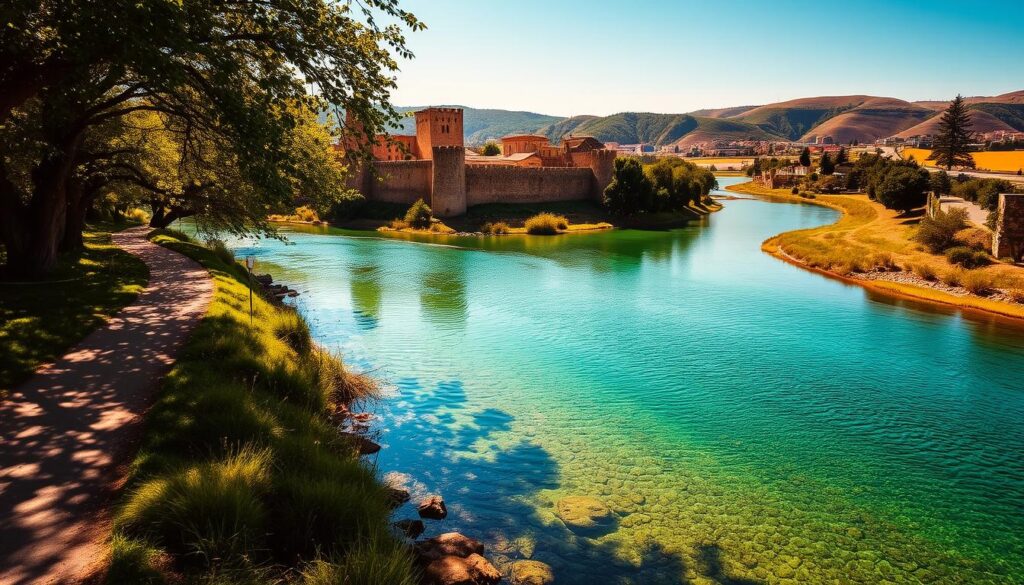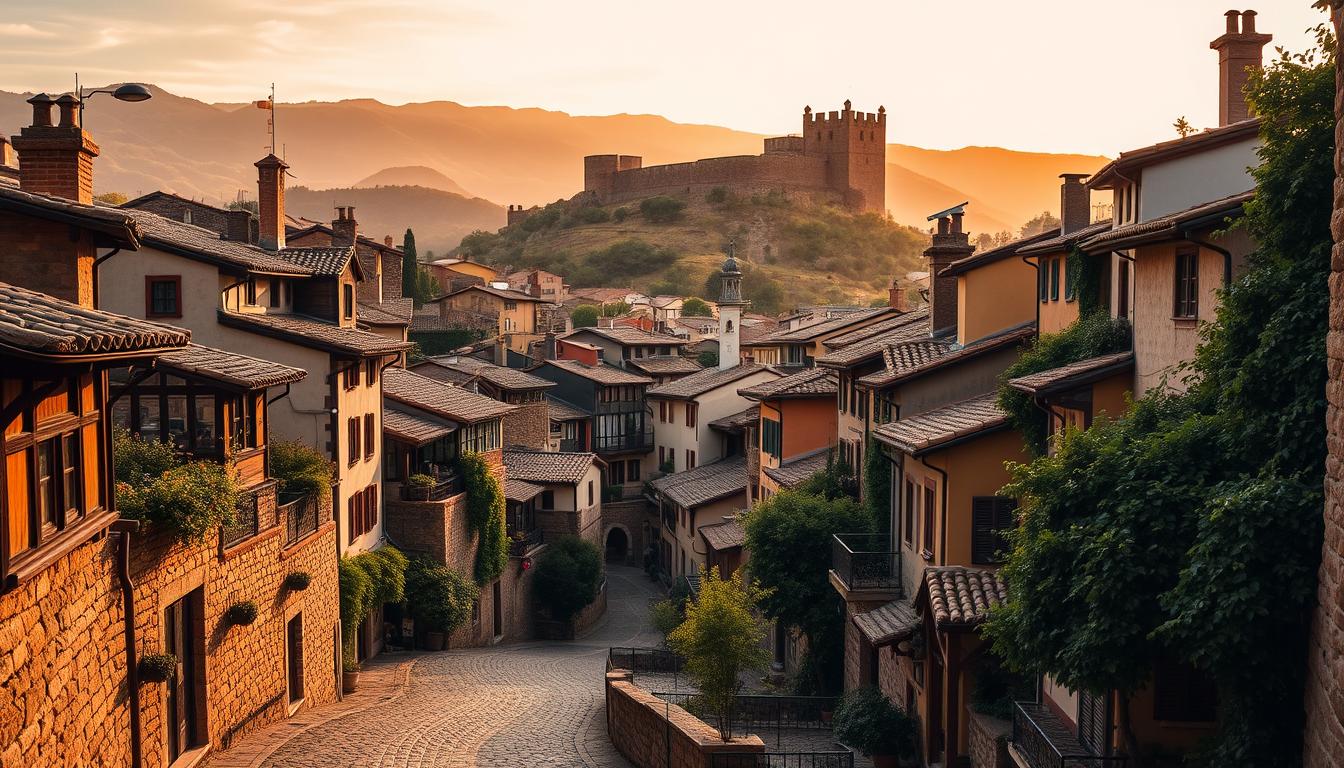I first arrive as the light turns warm, the old walls glowing like something out of a painting. I walk slowly because this place asks me to slow down. The bend of the Guadalaviar shapes every view and guides my steps.
My first impression mixes deep history and a lived-in charm. The Cathedral of El Salvador and the medieval fortifications anchor my route. Locals smile as if I belong, and restaurants treat me like a regular.
This short guide is practical and present tense. I focus on walking routes, viewpoints, food stops, and timing so U.S. travelers get a clear plan. I want your first day to feel familiar, not rushed.
The reward comes when you slow down: shaded alleys, small courtyards, and soft evening color reveal the real beauty. I write from that pace so your visit becomes an authentic experience rather than a checklist.
Key Takeaways
- I describe routes, meals, and timing for an easy first visit.
- The town blends historic landmarks with everyday life.
- Best moments come by walking slowly and watching light.
- Practical tips help U.S. visitors plan a meaningful day.
- Early arrival and late lingering make the place feel intimate.
Stepping into a storybook: my first look at Albarracín’s narrow streets and pink stone
I slip into the old lanes just after sunrise, when the stone keeps the night’s cool and the ironwork on doorways starts to gleam. The cobbles answer to my footsteps, and the town moves in small, careful breaths.
Plaza Mayor at dawn: wooden beams, coffee, and that quiet life
I pause at Plaza Mayor for a cup of coffee as the square wakes. Wooden balconies and medieval wooden beams frame the fountain. A few locals chat by tables; their names pass like familiar notes.
I move slowly, counting the hours by how shadows travel across terracotta facades. I trace a way through lanes so tight I can touch both sides. Every short turn offers a new view.
- I enter through narrow streets at sunrise and notice iron details above doorways.
- I listen to people greet each other and to the clink of cups — small rituals that shape the morning experience.
- I leave without hurry, knowing that every corner will reveal something fresh later.
| Sense | What I notice | Best time |
|---|---|---|
| Sight | Terracotta stone, wooden beams, arches framing hills | Dawn and late afternoon |
| Sound | Footsteps on cobbles, birds, soft voices | Early morning hours |
| Taste | Thick hot chocolate and café coffee | First pause at the plaza |
A fortress town shaped by time: walls, history, and every corner that tells a story
Walking the base of the fortifications, I notice how each layer of masonry names a different century. The original line of defense began around 965 in the Muslim period and grew after the 13th–14th century reconquest. That building rhythm still defines the walls that frame the streets.
From Islamic taifa to Aragon: why the ramparts still guide movement
I use the city’s long story—from taifa capital to Aragonese stronghold—as my walking guide. The bends and narrow climbs favor watchfulness. I read the history in changes of mortar and tower height.
Santa María and the Cathedral of El Salvador: bell tower silhouettes and sacred art
I step into santa maría and the Cathedral of El Salvador to rest in the cool nave. The glazed-ceramic bell tower becomes a landmark from almost every corner.
| Site | Era | What I see |
|---|---|---|
| Ramparts | 965 onwards | Layered masonry, towers, ramp walks |
| Cathedral | 16th–17th c. | Glazed bell tower, Episcopal Palace, sacred art |
| Old city | Medieval–Modern | Reddish houses, covered passages, steep streets |
albarracin fairy-tale village highlights I won’t skip
I reach the tower and the town arranges itself: roofs, cliffs, and the ribbon of river in one frame. From that line along the walls to Torre del Andador, the single best view ties roofs and cliffs to the bend below.
Walking the ramparts to Torre del Andador
I hike the ramparts up to the tower and pause. The path shows how rooftops step down the slope. I stay until the light shifts and the scene feels new.
Calle Azagra toward the Portal de Molina
I follow Calle Azagra into the old core. The streets keep a medieval logic that makes each turn feel deliberate and small discoveries constant.
Casa de la Julianeta and small details
I stop at Casa de la Julianeta and study the leaning facade. I let every corner tell me why timber beams and tiny plaques matter. I map my way through side alleys to avoid crowds and turn simple activities into slow observation. I watch where visitors bottleneck and time my return for late light.
| Highlight | What I do | Best time |
|---|---|---|
| Walls to Torre del Andador | Hike ramparts, pause at tower | Late morning or golden hour |
| Calle Azagra & Portal de Molina | Walk classic route, photograph facades | Early afternoon |
| Casa de la Julianeta | Study beams, read plaques | Late afternoon for fewer crowds |
This short loop is not a checklist but a framework for a richer experience. It confirms why this spot ranks among Spain’s beautiful villages and why I return to the same place in different light.
Nature wrapped around the walls: views, the Guadalaviar River, and protected landscapes
I begin near the Guadalaviar River, where wooden walkways hug the canyon and poplars frame calm water. The circular trail is an easy two-hour loop that sets the tone for my day.

Guadalaviar River walkways: easy paths, canyon curves, and peaceful hours
I walk slow and choose the river in the early morning for its soft light and few people. The route offers simple activities: steady steps, short rests, and clean views of cliff reflections.
Rodeno Pine Forests: red sandstone, hiking, and Levantine rock art
A short drive brings me to the Rodeno Pine Forests, where red sandstone and pines show off natural beauty. Marked trails and rock shelters put Levantine rock art in plain sight—like an open-air museum that makes the trip feel older and quieter.
Best viewpoints and sunset spots: timing my walk for the golden view
I time my return so the castle and cathedral areas glow at sunset. These views reward unhurried pacing, and I leave room for a second loop if the light asks for it. The brief pause by the river bend becomes the core of my experience.
Gastronomy I savor in town: migas, lamb stew, local cheeses, and a glass with a view
When the air cools, kitchens open and the town’s food becomes the clearest way to know a place.
I order shepherd-style plates because this gastronomy is rooted in the landscape: migas, slow-cooked lamb, trout from the river, and winter truffle.
Mountain flavors and seasonal plates
La Despensa de Tusta starts my meal with local goat and cow cheeses, fried cheese with tomato marmalade, and cordero guisado slow-cooked about four hours.
Casino is the terrace stop for Conserva Aragonesa, caldereta de cordero, and migas with grapes, paired with Navateros Roble.
Where I eat and simple tips I follow
Señorío de Albarracín shows creative takes—24-hour lamb, chicken liver pie, and desserts that nod to tradition while surprising the palate.
| Spot | Specialty | Why I go |
|---|---|---|
| La Despensa de Tusta | Local cheeses, cordero guisado | Humble cooking, people and recipes |
| Casino | Migas con uvas, caldereta | Terrace view, wine |
| Señorío | 24-hour lamb, creative desserts | Modern takes, rooted flavors |
I linger for days when a table invites it. My single clear tip: book peak dinners, come early for the best terrace seats, and leave room to follow a doorway that smells like slow stew. That small choice shapes the whole experience.
Local culture, events, and village vibes that make visitors feel at home
Music drifts from a plaza and, in a single beat, the day tilts toward late hours and easy conversation. I arrive open to local culture and let the calendar lead my steps.
Weekend fiestas and how the day changes
The “Party of the Village” is the biggest weekend event. Live music and activities run until about 3 a.m. I time meals and breaks around parades and concerts so my experience fits the pace of the streets.
During major festivities some restaurants and even hotels close so staff can celebrate. I see this as part of the charm, not an inconvenience.
Seasonal rhythms and nearby celebrations
Early September brings patron saint fiestas with processions, jotas, bull runs, and communal meals. Summer hosts the Festival de los Mundos in historic courtyards. October offers a lively medieval market where crafts and costumes fill lanes.
I spend alternate weekends visiting nearby villages, mapping a circuit of music and markets that extends the experience beyond the walls.
How I travel respectfully
I watch how people blend devotion and joy, and I keep simple tourism manners: give space to processions, ask before photographing, and follow local requests. This is the best way to be welcomed.
Plan my trip: when to go, how to get there, where to stay, and on-the-ground tips
Before I pack, I sketch routes, hotels, and the best hours for light. That simple plan saves stress and opens room for small discoveries.
Getting there from Madrid, Valencia, Zaragoza, or Teruel
I drive when I want freedom: Madrid via A-2 then A-23 is about 3.5 hours. Valencia and Zaragoza follow A-23 to A-1512 (roughly 2–2.5 hours).
From Teruel it’s an easy 38 km (about 40 minutes). If you skip a car, reach Teruel by train or bus, then take a taxi or rental to the town.
Best time to visit: seasons, hours of light, and quieter days
I choose spring for green hikes, summer for festivals and cool nights, autumn for golden trees and truffle menus, and winter for quiet, photogenic streets.
I budget my days around light: long morning shadows for lanes and late afternoon for the walls and viewpoints.
Hotels with history and views
I book Hotel Arabia for a central, family-run base with mountain views. I choose Hotel Albarracín when I want the most elegant stay in town.
Quick tips for on-the-ground travel
- Parking: free lots on the outskirts—walk in via the mapped paths.
- Tourist office: stop there for maps, event times, and current activities.
- Practical tips: carry cash, check restaurant days off, and pad your schedule for local fiestas.
| From | Route | Approx. time |
|---|---|---|
| Madrid | A-2 → A-23 | ~3.5 h |
| Valencia | A-23 → A-1512 | ~2.25 h |
| Zaragoza | A-23 → A-1512 | ~2.5 h |
I keep these simple tips handy so my trip runs smooth and my travel time turns into more time for the places I came to see.
Conclusion
I leave with a quiet feeling that this place teaches gentle rhythms more than quick itineraries.
I carry the history of the walls and the bell tower like small maps. The terracotta skyline, the Guadalaviar River bend, and the plaza mayor at dawn shape my memory of the town.
My best experiences were simple: walking streets, tasting migas, pausing for a golden view from the ramparts, and joining late-night events with welcoming people.
This visit asks for patience. It rewards time and quiet attention. I will visit Albarracín again to find new views, new days, and more of the local culture that keeps this beautiful village alive.


Lascia un commento